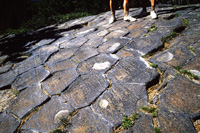


"Ten million atoms isn't cool, you know what's cool? Ten thousand atoms" *
High-energy cosmic rays shower the Earth's surface, penetrating meters into rock and producing long-lived radionuclides such as Cl-36, Al-26 and Be-10. Production rates are almost unimaginably small - a few atoms per gram of rock per year - yet we can detect and count these "cosmogenic isotopes" using accelerator mass spectrometry, down to levels of a few thousand atoms per gram (parts per billion of parts per billion!). The build-up of cosmogenic isotopes through time provides us with a way to measure exposure ages for rock surfaces such as fault scarps, lava flows and glacial pavements. Where surfaces are gradually evolving, cosmogenic isotope measurements allow us to calculate erosion or soil accumulation rates.
This site explains some of the background to our work and provides an overview of cosmogenic isotope research at the University of Washington. It also serves as a repository for data generated by the group, descriptions of our lab procedures, technical information and calculation methods.
This web site is partially supported by grants from the National Science Foundation.
